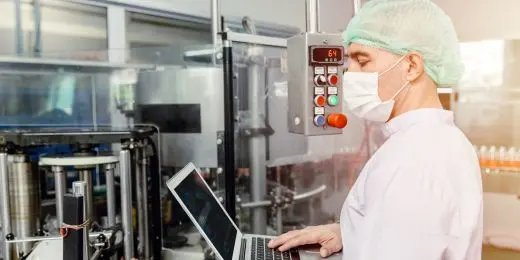Why is Temperature Monitoring Important?
It is a legal requirement in the food industry and a key feature of any Food Safety Management System—like HACCP, ISO, or HARPC—that food temperature be monitored. If not stored properly, food (especially Time and Temperature Control for Safety or TCS food) can spoil or bacteria can grow, leading to consumer health risks that can cause financial strain and reputational damage to your business.
To address food risks, regulatory obligations require that hot and cold food temperatures be monitored and a temperature log be maintained. Food temperature monitoring is typically done manually 2 times a day with a temperature log.
Today, businesses are improving their operational performance with the help of technology. Remote monitor temperature systems give business owners 24/7 visibility of their most valuable assets even when they are not on location. With certain technology becoming cost-effective, reliable and easy to use, remote temperature monitoring now gives businesses the opportunity to deliver great customer experience and improve their profitability.
6 Benefits of Remote Temperature Monitoring
Remote temperature monitoring systems use sensors to record real-time updates on temperature changes. It helps prevent temperature-sensitive food spoilage and ensures their quality. It has become increasingly popular in food safety due to its numerous benefits including the following:
1. Avoid stock loss and health issues with real time monitoring and alerts
We all know that a fridge or freezer breakdown can result in potential food loss and wastage and have a real negative financial and operational impact on a business. Remote temperature and humidity monitoring turns your operation from reactive to proactive. Typically, temperature sensors capture data every 10-20 minutes providing customers with 24/7 visibility of what is going on with their high value assets. Some monitoring systems send alerts and notifications immediately to the people who need to know straight to their mobile phone with a SMS, text, and email. Reducing stock loss not only reduces avoidable expenses but more importantly minimizes the risk of operational downtime.
2. Save time on compliance and reporting
While maintaining strict temperature control is a critical part of food safety management, maintaining compliance should not have to be difficult and time consuming. Compliance is ultimately the responsibility of the chef or head of food operations, who is almost always extremely busy and is expected to be more focused on customer experience and optimizing operations. Maintaining a manual, paper-based temperature logs and food safety management systems requires a lot of time, is prone to error or loss of data, and double handling of information from paper to a digital record.
Automating temperature recording and the ability to easily generate reports, significantly reduces time spent arranging compliance obligations and gets the team back to focusing on what’s most important—the customer.
3. Improve customer experience, brand reputation, and food quality
With regular and more accurate temperature and humidity alerting, the team can start making proactive and informed decisions to ensure that food remains fresh for longer. Fresh food ultimately means improved food quality and safety. Better food quality improves the customer experience and your brand reputation, which ultimately drives return customers and improved profitability.
4. Save time on training and avoid human error, for franchises in particular
In operations where there are multiple stores, and in the case of franchises—multiple store owners—it becomes increasingly difficult for a business to continue to track quality and ensure consistent brand and quality standards across the network. Maintaining consistency is time consuming and requires significant investment from the corporate team in regular training for all employees, who in a lot of cases are part time workers and change regularly. Automated monitoring reduces time and money spent on regular training on the subject, and also eliminates potential for human error across all sites.
5. Improved sustainability through reduced energy consumption and paper usage
With more data comes more insight and the need to maintain records. Automated data monitoring gives businesses more accurate information about the temperature of the environments they are tracking. Businesses will quickly be able to identify when temperature is colder than what is required. In this instance, businesses have the ability to increase equipment temperatures, optimizing the performance of assets while reducing energy consumption. The result is that businesses continue to improve sustainability and reduce costs. In addition, continuing to digitize manual paper based processes also helps to improve business sustainability goals.
6. Utilize data to do predictive maintenance on your high value equipment and assets
Start to use sensor data to predict when your equipment is in need of service or repair before it breaks. Temperature and humidity ranges are typically within a well-defined range when the equipment—like a fridge or freezer—is working correctly. When the temperature starts to deviate outside acceptable ranges, it can mean that the equipment motor is starting to wear out or an action needs to be made. Tracking the data and receiving alerts when the equipment deviates allows businesses to address issues before they become more serious.
Uphold food safety and quality standards with SafetyCulture
Enhance operational efficiency with monitoring sensors. Track real-time data and insights to never miss another food safety incident.
Explore this solutionKey Takeaway
Remote temperature monitoring systems can save you thousands of dollars annually in food waste or spoiled goods and, more importantly, increase your profitability by delivering quality customer experience through reliable, cost-effective, and user-friendly solutions.
Why Marley Spoon Use SafetyCulture (formerly iAuditor)
“I received an SMS alert late one Saturday night saying that the temperature in our cold storage was rising. If we had only found out about it when we arrived on Monday, we would have had to throw out everything in the cold room. That one little message saved us tens of thousands of dollars.” – Sophia Dias, Food Safety and Quality Manager at Marley Spoon.




